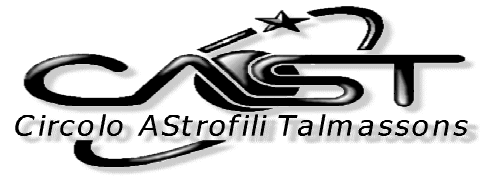
La missione STS 114 (26 luglio 2005 - 9 agosto 2005)
di Lucio Furlanetto
Per chi legge dal cd-rom: Scheda introduttiva sugli obbiettivi della missione STS 114 (aggiornato al 22 luglio 2005)
Chi legge da internet clicchi questa pagina (855 KB).
La missione STS-114 ritorna nello spazio oltre due anni e mezzo dopo la precedente STS-107, culminata il 1 febbraio 2003 con la perdita
in fase di rientro dello space shuttle Columbia e di tutti i membri del suo equipaggio. Il Columbia esplose in volo a pochi
minuti dall'atterraggio sulla pista di Cape Canaveral, causando la morte di tutti e sette i membri dell'equipaggio: Rick D. Husband
(comandante della missione), William C. McCool (pilota), David M. Brown, Laurel B. Clark e Kalpana Chawla
(specialisti della missione), Michael P. Anderson (payload commander), tutti americani, e Ilan Ramon (israeliano, payload
specialist).
Chi desiderasse approfondire l'argomento legga l'articolo "Là dove non osano le aquile..."
parte 1 e
parte 2.
La missione: la sua preparazione e gli obiettivi
Il 1° giorno della missione
Il 2° giorno della missione
Il 3° giorno della missione
Il 4° giorno della missione
Il 5° giorno della missione
Il 6° giorno della missione
Il 7° giorno della missione
L'8° giorno della missione
Il 9° giorno della missione
Il 10° giorno della missione
L'11° giorno della missione
Il 12° e 13° giorno della missione
Il 14° e 15° giorno della missione
Il dopo missione
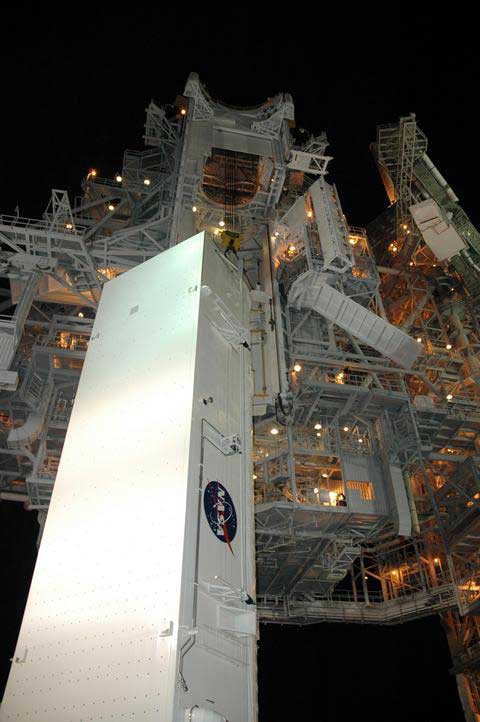
| |
Launch Pad 39B
Il Launch Pad 39B ripreso prima del lancio dello space shuttle Discovery a Cape Canaveral, il grande complesso di sostegno e
supporto dello shuttle. La missione STS-114 ritorna nello spazio oltre due anni e mezzo dopo la precedente missione, culminata
con la perdita in fase di rientro dello space shuttle Columbia e di tutti e sette i membri del suo equipaggio.
Il "carico pagante", che comprende gli eventuali satelliti da lanciare nello spazio e/o i moduli scientifici ancorati nella "baia di
lancio" dello space shuttle, viene inserito nell'apposito contenitore nella Payload Changeout Room, la speciale sala in condizioni
climatiche controllate e totale assenza di polvere e impurità, che è uno dei luoghi più asettici che ci siano. A sua volta il contenitore
viene inserito nella stiva dello shuttle dalla quale, una volta aperto il contenitore, sarà lanciato in orbita oppure, come in altri casi
coi moduli scientifici, sarà aperto per effettuare una serie di esperimenti scientifici.
Il carico pagante di questa missione del Discovery include il Multi-Purpose Logistics Module Raffaello, il Lightweight Multi-Purpose
Experiment Support Structure Carrier (LMC) e l'External Stowage Platform-2 (ESP-2). Il Raffaello sarà consegnato come fornitura
all'International Space Station nel quale ci sono pure cibo, vestiario e equipaggiamento scientifico per ricerca. Il LMC porterà con sè un
rimpiazzo del Control Moment Gyroscope e una scatola di campioni per riparare le piastrelle dello shuttle. L'ESP-2 è fornita con parti
di ricambio.
Image credit: NASA/KSC
|

| |
I Media
I media si sono radunati davanti all'Operations and Checkout Building per seguire le fasi del lancio dello space shuttle
Discovery. Dalla tragica precedente missione sono trascorsi due anni e mezzo.
Cliccando l'immagine l'aprirete a 6019 x 800 pixel.
Image credit: NASA TV
|

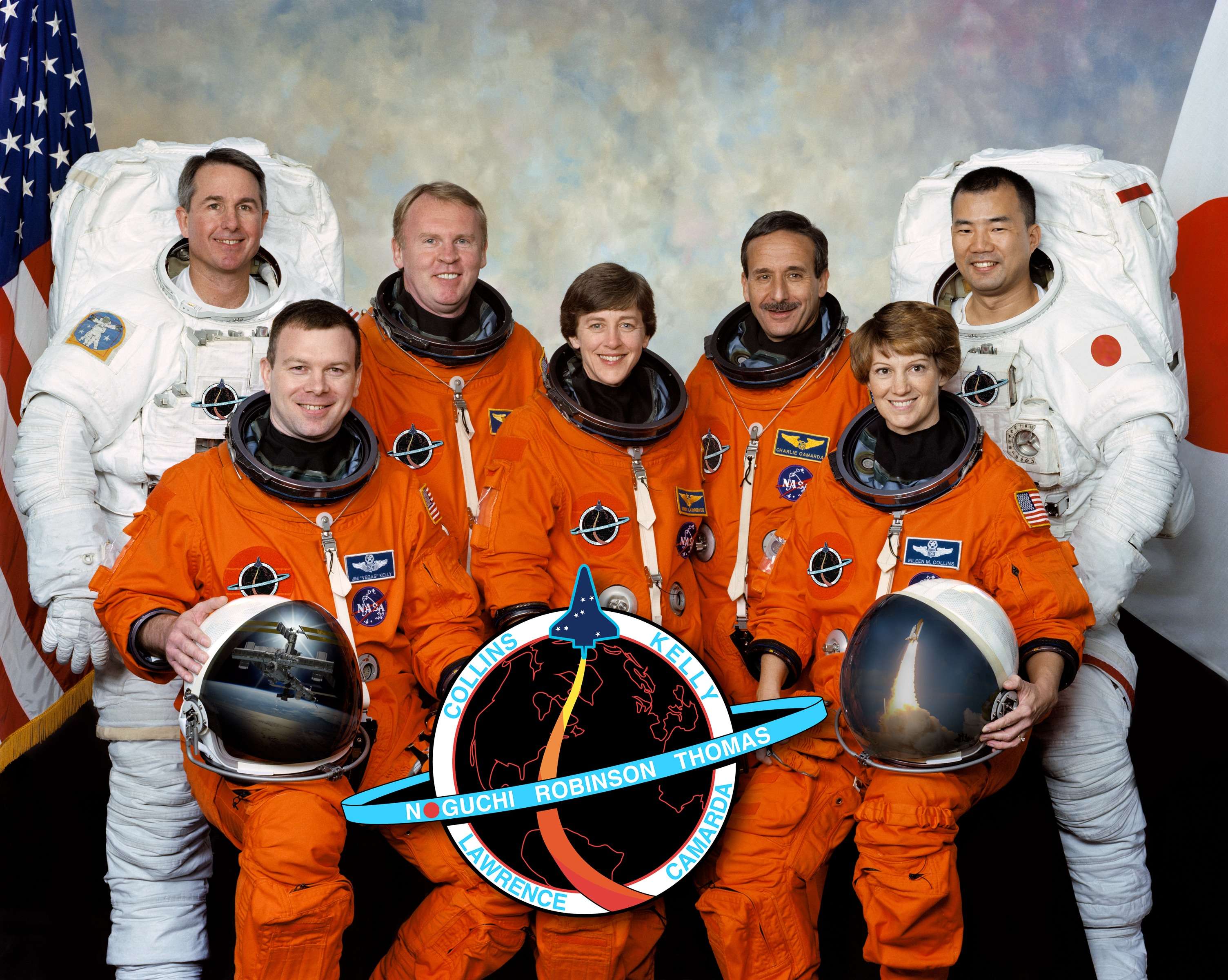
| |
La fotografia ufficiale dell'equipaggio
L'equipaggio della missione STS-114 che volerà sullo Space Shuttle Discovery è quì ripreso nella fotografia ufficiale.
Da sinistra sono gli astronauti Steve Robinson, Jim Kelly, Andy Thomas, Wendy Lawrence, Charlie Camarda, Eileen Collins e
Soichi Noguchi, quest'ultimo dell'Agenzia Spaziale Giapponese. Cliccando l'immagine l'aprirete a 3008 x 2004 pixel.
Image credit: NASA
|
Di seguito riporto le schede biografiche dei sette membri dell'equipaggio, tratte dall'apposita pagina del sito internet della NASA.
Il testo in americano sarà tradotto quanto prima.
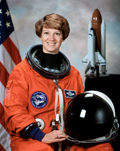
| |
Comandante Eileen Collins
Eileen Collins will serve as commander on her fourth Space Shuttle flight and second flight as commander. She served as pilot on mission STS-63 in 1995 and mission STS-84 in 1997, and was commander on mission STS-93 in 1999. Collins will command the crew and mission on orbit. She will dock Discovery with the Station and fly the orbiter to its landing at Kennedy Space Center. Collins has Masters Degrees in operations research from Stanford University and space systems management from Webster University. She was born in Elmira, New York.
During Crew Equipment Interface Test activities at Kennedy Space Center in February, Commander Collins inspects the window in Discovery's cockpit. During the interface test, the STS-114 crew had an opportunity to get a hands-on look at the payloads they'll be working with on orbit.
Collins recently talked about mission STS-114 and the goals the astronauts aim to achieve.
"Well, the LF stands for logistics flight. I mean, primarily, STS-114 is a resupply, re-servicing, repair of the International Space Station. But we also have an objective of the flight that's equally as important and that's the test -- I mean, you could call this a test and logistics flight because the testing that we're doing is for the recommendations that came about after the accident in the inspecting, inspecting the exterior of the orbiter and the External Tank and testing repair methods. So we really have, I see it as, as two major objectives on the flight."
Image credit: NASA
|
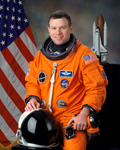
| |
James Kelly
James Kelly will serve as pilot on his second Space Shuttle flight. He served as pilot on mission STS-102 in 2001. During mission
STS-114, Kelly's primary responsibility is to serve as backup to Commander Collins. He will operate the orbiter's robotic arm during
vehicle inspections with the OBSS. He will also operate the Station's robotic arm during all three spacewalks, as well as during the
transfer and retrieval of the Multi-Purpose Logistics Module. Kelly has a Masters Degree in aerospace engineering from the University
of Alabama. He was born in Burlington, Iowa. During a visit to Kennedy Space Center, Kelly looks closely at an area of an engine on
the orbiter Discovery inside the Orbiter Processing Facility. Kelly recently spoke about his primary responsibilities as pilot for
mission STS-114. "Well, the primary job of the pilot in, in every flight, obviously, my first job is to back up the commander. So,
Eileen Collins is our commander, and although she's totally competent to do absolutely everything, we never do everything with one
person. We always have someone to back them up. So my primary job is to back up Eileen pretty much in anything she does: flying the
vehicle, reconfiguring the vehicle, all those kind of things, so that's my job number one. Probably the second biggest job I have is
robotics for this flight. I'm a robotics operator on both the Shuttle arm, helping out with all the inspection processes, with the
inspection boom and sensors and all of those things, as well as I'm a Station robotic arm operator, primarily for doing all of the
EVAs, all of the spacewalk work, as well as the logistics module back and forth, onto the Station and back in the payload bay. So most
of my time in flight is going to be taken up with the robotics operations."
Image credit: NASA
|
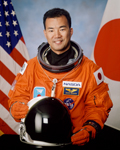
| |
Soichi Noguchi
Soichi Noguchi, with the Japan Aerospace Exploration Agency, will serve as mission specialist 1. This is his first Space Shuttle
flight. During the mission, Noguchi will be the lead spacewalker during three spacewalks to demonstrate repair techniques on Thermal
Protection System samples, replace a failed Control Moment Gyroscope and install the External Stowage Platform on the Station. Noguchi
has a master of engineering degree in aeronautical engineering from the University of Tokyo. Noguchi was born in Yokohama, Kanagawa,
Japan. During preflight training, Noguchi checks a potential repair technique for the Shuttle's heat protection tiles at the Neutral
Buoyancy Laboratory at Johnson Space Center in Houston, Texas. The latest techniques and hardware were developed for Noguchi to use
during an in-flight test of new Shuttle heat shield repair possibilities on mission STS-114. Noguchi recently talked about what will
be accomplished during his first spacewalk, along with Mission Specialist Stephen Robinson. "The first EVA, first spacewalks, will
be mainly dedicated to demonstration of the repair techniques. Steve and I will move to the cargo bay, the very back portion of the
cargo bay, and there is a special box dedicated to this demonstration. And it's the size of like, four feet by three feet. And we will
open this big box, and inside the box there is a kind of a simulated damage of the tiles and, uh, possibly RCC, the leading edge panel,
and we will be performing the repair using a special repair equipment. And, what we like to do is shoot the goop into the grooved area
of the tile and see how it cures and how we can operate the equipment under the zero G and other vacuum environment. And once we come
back to ground, then engineers will put them onto the arc jet test facility to make sure they will withstand entry profile."
Image credit: NASA
|
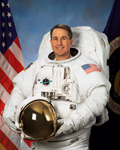
| |
Dr. Stephen Robinson
Dr. Stephen Robinson will serve as mission specialist 2 on his third Space Shuttle flight. He will serve as the flight engineer during the launch and landing of mission STS-114. Robinson will perform three spacewalks with Noguchi to demonstrate repair techniques on all protection system samples, replace a failed Control Moment Gyroscope, and install the External Stowage Platform on the Station. Robinson has a Ph.D in mechanical engineering, with a minor in aeronautics and astronautics, from Stanford University. He was born in Sacramento, California.
During preflight training, Robinson uses virtual-reality hardware in the Space Vehicle Mockup Facility at Johnson Space Center to rehearse some of his mission STS-114 duties.
Robinson commented on his primary mission responsibilities.
"My job on this mission is really two separate things. On launch and on entry, I'm flight engineer on board, which means Eileen [Collins], as the commander, and Jim Kelly, as the pilot, will be sitting in their seats, and I sit in a seat sort of a little behind and in between them, and I'm responsible for understanding all the systems of the Space Shuttle, helping the right information flow get to the right person in the cockpit, and in particular, that becomes important when there's any malfunctions. In flight, there's not too many malfunctions, but in training there's lots of them, so we get to train for lots of, be ready for anything, basically. So I'm part of the cockpit crew. While we're up there, my job is to be a spacewalker, and Soichi Noguchi and I will do three different spacewalks on the fifth, the seventh, and the ninth day of the mission."
Image credit: NASA
|
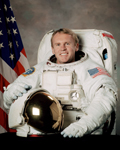
| |
Dr. Andrew Thomas
Dr. Andrew Thomas will serve as mission specialist 3 on his fourth Space Shuttle flight. Previously, he flew on mission STS-89
in 1998, which was a docking mission with Mir. Thomas served aboard Mir as flight engineer 2 for 130 days and returned to Earth on
mission STS-91 in June 1998. Thomas will help unberth the OBSS in Discovery's payload bay and attach it to the orbiter's robotic arm
to inspect the vehicle for any damage. Thomas was born in Adelaide, South Australia. He received a Ph.D. in mechanical engineering
from the University of Adelaide. During the March Crew Equipment Interface Test at SPACEHAB in Cape Canaveral, Thomas checked out
components on the External Stowage Platform-2. The platform, carried in Discovery's payload bay, will carry replacement parts, known
as orbital replacement units, to the Station. Thomas recently commented on how the Space Station will help the nation achieve the
Vision for Space Exploration and pave our future. "...a lot of people don't understand that the Space Station and what we're doing
with it is really going to help us go beyond low-Earth orbit. And it's a connection that a lot of people don't appreciate. If you're
going to go beyond low-Earth orbit to the Moon or a six-month journey to Mars, you have to have systems in your spacecraft that you
know will run continuously for long periods of time. You're going to have the right life-support systems, you've got to have the right
electrical systems, propulsion systems. Everything has to work properly because when you do a mission to Mars there's no going back.
If something's wrong, you can't just get down to Earth and fix it. The Space Station is going to teach us how to do that. It's teaching
us what kind of technologies you need to operate and maintain a spacecraft in the hostile environment of space for long periods of
time as you would have to do if you were doing a deep-space interplanetary mission. That's one thing. There's the human element,
too: Space Station's teaching us what is required of us as humans to live and function in space. It's teaching us what is the consequence
of living in space on us as human beings, and it's teaching us how to mitigate some of them, the deleterious effects, of space flight.
We need to have answers to all of those questions if we're going to go on beyond low-Earth orbit to the Moon or to Mars."
Image credit: NASA
|
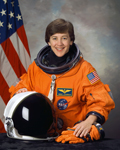
| |
Wendy Lawrence
Wendy Lawrence will serve as mission specialist 4 on her fourth Space Shuttle flight. Previous missions include STS-91 in June 1998,
STS-86 in September 1997, and STS-67 in March 1995. Lawrence's work on mission STS-114 includes helping to position the orbiter beneath
the Space Station to allow Station crew members to photograph the underside of Discovery. She will also lead the transfer of racks from
the MPLM Raffaello into the Station and the used supplies, equipment and hardware from the Station into the module for return to Earth.
Lawrence was born in Jacksonville, Florida. She earned a masters degree in ocean engineering from MIT and the Woods Hole Oceanographic
Institution. During the Terminal Countdown Demonstration Test on May 4 at KSC, Lawrence prepares to enter the hatch on Space Shuttle
Discovery from the White Room on Launch Pad 39-B. TCDT provides the crew of each mission an opportunity to participate in various
simulated countdown activities. Lawrence recently talked about her primary responsibilities on mission STS-114. "I'm in charge of all
the transfer operations, so the LF part of this flight designation is near and dear to my heart. We have a Multi-Purpose Logistics Module
in the payload bay that's going to be carrying thousands of pounds of equipment and food and other items for the Space Station, and so
we'll install that on Flight Day 4. And then we'll start the transfer operations and, hopefully by Flight Day 10, we've got everything
done. We're actually on this flight bringing more back to Earth than we are taking up to the Space Station... A lot of the equipment on
the Space Station is reusable, and it's time to bring it back down to Earth so it can be refurbished and flown again. And we're going
to be bringing home quite a bit of equipment for the Russian space program, some of the rendezvous radar equipment that they use for
the Progress and Soyuz vehicles."
Image credit: NASA
|
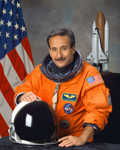
| |
Dr. Charles Camarda
Dr. Charles Camarda will serve as mission specialist 5 on his first Space Shuttle flight. Camarda will serve on the rendezvous team
with Lawrence and Collins. He will help guide the orbiter beneath the Space Station so the Station crew members can photograph Discovery
before docking. Camarda was born in Queens, New York. He has a Ph.D in aerospace engineering from Virginia and Polytechnic Institute and
State University.
During preflight training, Camarda checks data on a monitor in the aft section of the cabin of the fixed-base Shuttle mission simulator
at Johnson Space Center's Mission Simulation and Training Facility. The rehearsal was part of a long-duration integrated simulation for
the STS-114 flight. Camarda recently talked about inspections of the outside of Discovery during the mission.
Image credit: NASA
|

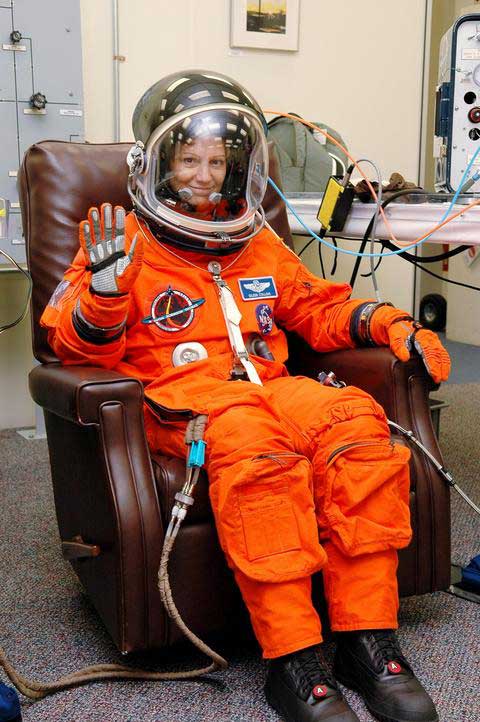
| |
La comandante
La comandante della missione che impiega lo space shuttle Discovery è Eileen Collins, una pilota che ha già volato con lo shuttle
e vanta due lauree. Dotata di notevole sangue freddo, viene ricordata perchè in una precdente missione partì mentre si accendeva una spia
che segnalava un "guasto" a pochi secondi dal distacco dalla rampa: svolse correttamente tutte le procedure del caso.
La Collins è qui ripresa mentre si trovava nel "Operations and Checkout Building" al NASA Kennedy Space Center, con indosso la
tuta e l'elmetto chiuso come in volo. A lei tocca l'onore di riportare la navetta in volo, a due anni e mezzo dal disastro del
Columbia, e soprattutto di rifornire l'International Space Station che attendeva da tre anni le parti caricate nella stiva.
Image credit: NASA/KSC
|
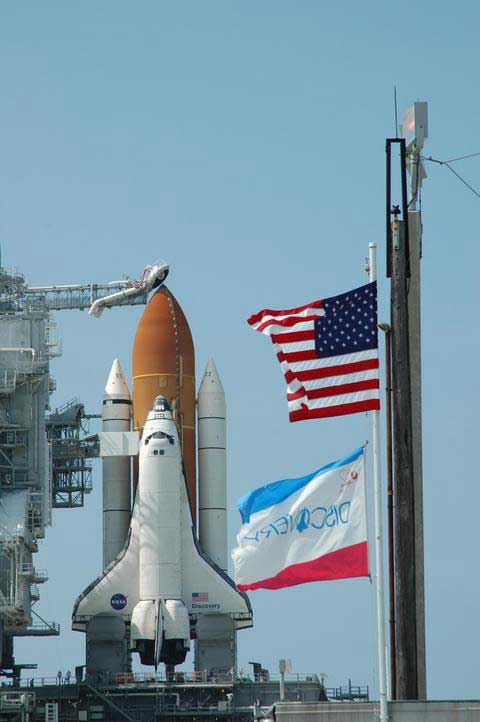
| |
Sulla rampa si è concluso il rifornimento di idrogeno e ossigeno del serbatoio esterno
Lo shuttle Discovery è sulla rampa di lancio, la Launch Pad 39B del NASA Kennedy Space Center, dopo il rollback della
Rotating Service Structure di lunedì 25 luglio 2005. E' chiaramente visibile il gigantesco serbatorio esterno
(External Tank) che è stato riempito di ossigeno e idrogeno liquidi
dall'apposito sistema di rifornimento (visibile proprio sopra la punta del serbatorio). In fase di propulsione i due gas liquefatti
sono riscaldati e, combinandosi, producono vapor acqueo e l'energia necessaria per la propulsione.
Il serbatorio esterno è unito alla navetta vera e propria del complesso chiamato Space Transport System (STS), lo space shuttle,
da una serie di attacchi esterni che potete vedere in un disegno della NASA.
Al momento della partenza (liftoff), il serbatoio assorbe completamente il carico della spinta dei due booster laterali e dei tre motori
principali, riforniti proprio dal propellente e dal comburente stivati nel grande serbatorio esterno, una spinta che è pari a ben 7,8
milioni di libbre, corrispondenti a oltre 3,5 milioni di kg(p).
La rotazione all'indietro della Rotating Service Structure è la più importante operazione prima del volo; essa occupa la fase
a 11 ore dal lancio e tipicamente avviene il giorno precedente: in gergo si dice "the T-11-hour hold on L-1 (the day before launch)".
Image credit: NASA/KSC
|
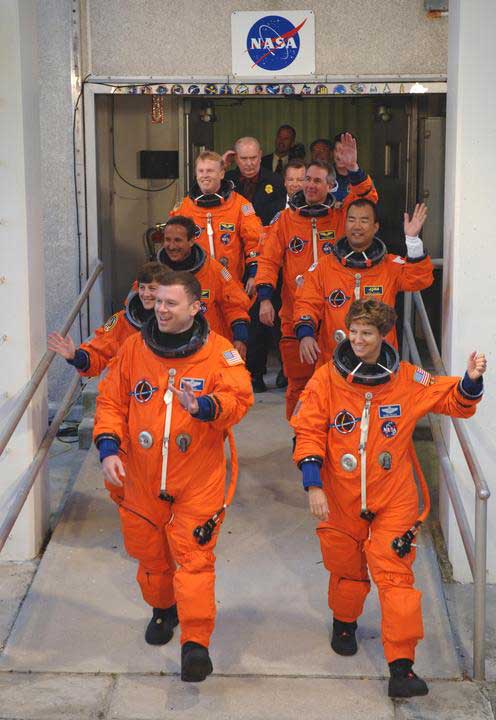
| |
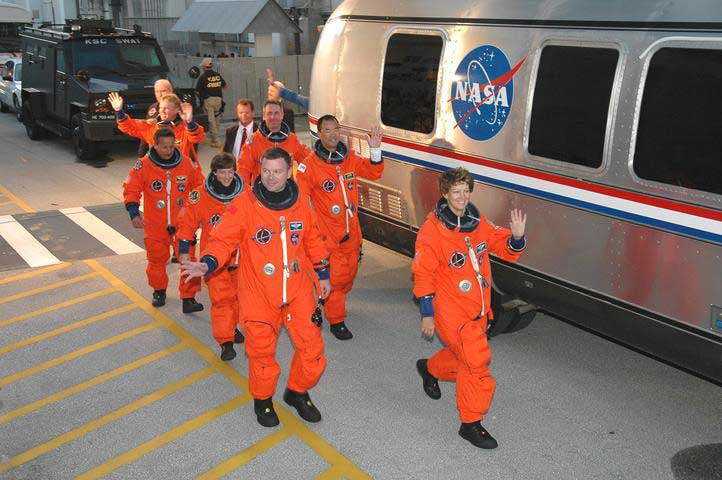
| | |
La partenza col bus che li porterà all'imbarco sul Discovery
La comandante Eileen Collins (davanti sulla destra) assieme all'equipaggio della missione STS 114, ripresi a sinistra mentre
escono dall'Operations and Checkout Building dove si sono vestiti e a destra mentre percorrono il tragitto verso l'autobus che li porterà
al Launch Pad 39B, salendo il quale entreranno nella cabina dello space shuttle Discovery.
I membri dell'equipaggio sono sette: Eileen Collins (comandante della missione), James Kelly (pilota), Andrew Thomas,
Soichi Noguchi, Charles Camarda, Wendy Lawrence e Stephen Robinson (specialisti della missione).
Image credit: NASA/KSC
|
|
Per approfondire l'argomento consiglio di visitare i seguenti siti:
STS 114 - la missione
Space Shuttle: Before the Countdown
Space Shuttle system
Le missioni al Kennedy Space Center
News from Kennedy Space Center
http://www.nasa.gov
NASA Television
Archivi: le missioni dal 1999 al 2004
Le News della NASA e di Space.com
STS-114 Mission & Crew Briefing (06/07/2005)
STS-114 Events, Briefings and KSC News Center Operating Hours Set (08/07/2005)
STS-114 Cathy Koerner: Flight Director Living a Dream That Began Early (uno dei tre direttori di volo dell'STS-114; 24/08/2004)
STS-114 Return to Flight Mission
NASA Chief: Discovery May Not Launch Until Next Week (13/07/2005)
Discovery's STS-114 Crew Arrives at Launch Site
Sensor Glitch Scrubs Discovery Launch
Space Tools: Off the Shelf, Onto the Shuttle
Discovery's On-Board Souvenir Stash
Space Shuttle Discovery Repaired at Launch Pad (12/07/2005)
NASA Chief: Discovery Shuttle Set to Fly
Launch Anticipation: Mixed Feelings About Discovery’s Flight
The Discovery Mission: NASA’s Countdown to Credibility
Shuttle Discovery on Track for Wednesday Launch (11/07/2005)
Florida Today: 2004 Hurricanes Caused Frustration (09/07/2005)
Experience the Mission and Crew Briefings of Past Shuttle Missions (STS #92-114)
Shuttle Status Reports 2005.html (14/07/2005)
Space Station Astronauts Eagerly Await STS-114 Crew's Arrival
Space Station Astronauts Eagerly Await STS-114 Crew's Arrival
Mission Columbia: STS-107 Story and Multimedia Archive
NASA - Apollo 11 Launch (Archive) (il 20 luglio ci sarà il 36° anniversario)
NASA - Apollo 11 Launch (Full Image: 25 MB) (Immagine del lancio)
Torna a inizio pagina
Articoli |
Fotografia, ccd e ricerca |
Dizionario |
Notiziari
Homepage
Copyright © 2005-2006 di Lucio Furlanetto
Immagini copyright copy; 2005 di NASA/KSC

Pagina caricata in rete 26 luglio 2005; ultimo aggiornamento (9°): 6 febbraio 2006
|

















